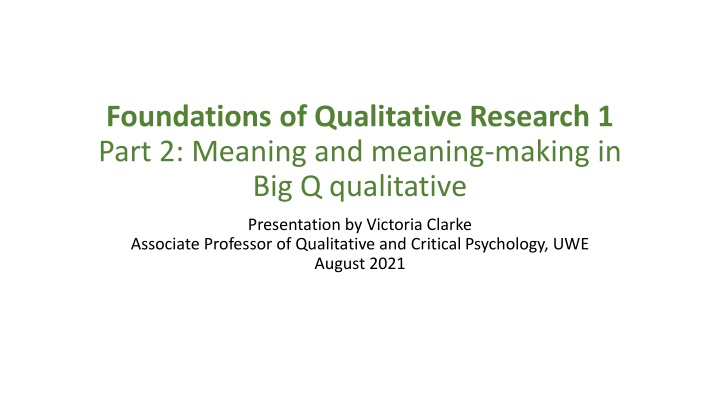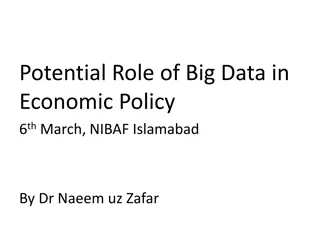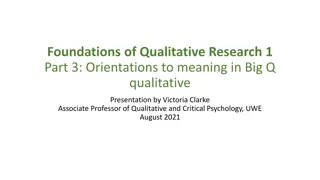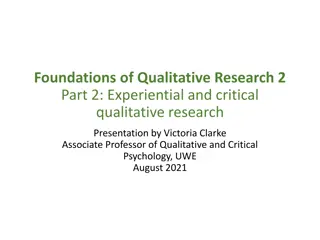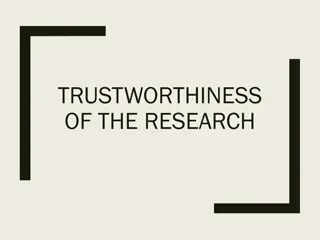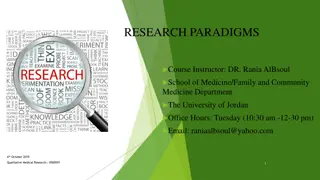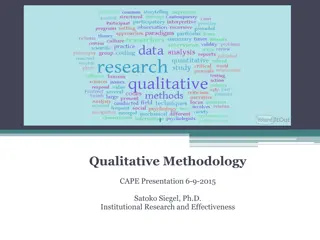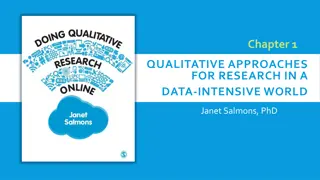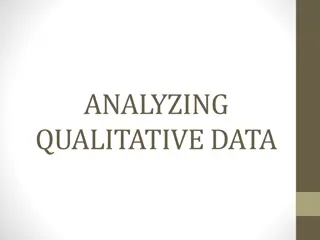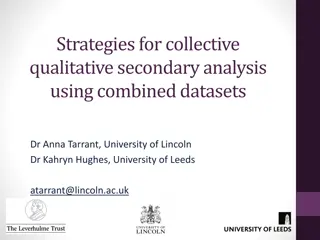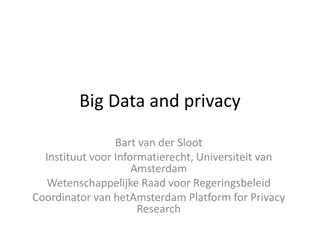Meaning and Meaning-making in Big Q Qualitative Research
Qualitative research explores different understandings of meaning and meaning-making, providing researchers with tools, techniques, and values. Big Q qualitative research focuses on the active role of words in creating meaning beyond reflecting experiences. This lecture series delves into the foundations of qualitative research, emphasizing the significance of interpreting meanings in research endeavors.
Download Presentation

Please find below an Image/Link to download the presentation.
The content on the website is provided AS IS for your information and personal use only. It may not be sold, licensed, or shared on other websites without obtaining consent from the author.If you encounter any issues during the download, it is possible that the publisher has removed the file from their server.
You are allowed to download the files provided on this website for personal or commercial use, subject to the condition that they are used lawfully. All files are the property of their respective owners.
The content on the website is provided AS IS for your information and personal use only. It may not be sold, licensed, or shared on other websites without obtaining consent from the author.
E N D
Presentation Transcript
Foundations of Qualitative Research 1 Part 2: Meaning and meaning-making in Big Q qualitative Presentation by Victoria Clarke Associate Professor of Qualitative and Critical Psychology, UWE August 2021
PowerPoint slides from the Braun, Clarke & Hayfield Qualitative Methods Online Teaching & Learning Resources Collaboration (QMOTLRC) Image of a white woman - Virginia Braun - a head and shoulders shot, she is wearing a red and white striped long sleeved top and glasses, and has her hands resting on either side of her face
Topic overview oThis is the first of two lectures each divided into three parts - exploring the values, characteristics and theoretical foundations of qualitative research. oThe aim of this first lecture is to provide an accessible introduction to qualitative research, for those with some research training. We try to use minimal specialist terminology (this will come in the second lecture!). oThis lecture explores different understandings of qualitative research as providing researchers with tools and techniques and as providing both tools and techniques, and research values. oWe then explore the central importance of meaning and meaning-making to qualitative enquiry and some different orientations to meaning. oThere are some opportunities to pause the recording and reflect on your knowledge and understanding of qualitative research.
Lecture overview oPart 1: What is qualitative research? oPart 2: Meaning and meaning-making in Big Q qualitative oPart 3: Orientations to meaning in Big Q qualitative
What defines Big Q qualitative? Many will say a focus on experience that qualitative research gives us access to and makes sense of people s experiences of themselves, of others and the world. Although this is a common answer it s only part of the story. Not all qualitative research is concerned with how participants make-sense of their worlds and experiences, their understandings, perspectives, values, practices and behaviours. Qualitative research can also be concerned with social processes that expand beyond individual experience, and with the norms and rules governing human action. However, all these types of qualitative research are sometimes dubbed experiential because they understand participants words as reflective of underlying experience, thoughts, feelings, motivations and so on.
Big Q is all about meaning For some qualitative researchers, words don t simply reflect an (experiential) reality of perspective; they do things , they are active like: the contracting words of a civil marriage ceremony ( I call upon these persons here present, to witness that I Rob do take thee Jon to be my lawful wedded husband ) an instruction ( hold the door ) or the making of a knight ( arise ) This means the research focus shifts from individual sense-making to meaning as a social process and product. If we have to choose one word or concept to define qualitative research we think meaning is a better choice than experience. An important question is then
What type of meaning am I interested in? Psychological meaning people s inner life, their subjective experience of the world, how they make sense of this experience, their understandings, views, beliefs and motivations, their actions and behaviours. Individual meaning located in a social context retaining a focus on individual experience but recognising this as thoroughly socially and situated within a wider social context. Social meaning a focus on meaning as a social process and product that expands beyond the individual.
Psychological meanings Let s consider an example Psychologists Smith and Osborn s (2007) study of chronic pain. Interviews with 6 people. All experience chronic benign lower back pain. Reported 5 themes exploring experience of the self in chronic pain: Negative impact of pain on the self. Continuum and trajectory: the negative impact of pain is potentially a developmental process: positive original self > negative pain self. Public arena makes it worse: participants worried about the impact of pain on their relationships and families and how they were viewed by others. Directing negativity at others: the pain self contaminates relationships with significant others. Sting in the tail: pain > negative thoughts > self-loathing > negative behaviour towards others > punishment.
Locating individual experience in a social context Sociologists Hislop and Arber s (2003) research on the gendered nature of sleep disruption. Sleep diaries (audio recorded each morning for a week) from 12, and 6 focus groups with a total of 48, mid-life women, most married or partnered with children. The nature of mid-life women s sleep. The social context of mid-life women s sleep. Children and mid-life women s sleep. Partners and mid-life women s sleep. Women s responses to sleep disruption behavioural strategies, relocation staying in the double bed, permanent relocation, contingency relocation.
Social meanings Social psychologists Clarke & Braun (2019) research on sense-making around male body hair depilation. Story completions from 98 young people those at the sharp edge of depilation pressures. Story stem: David has decided to start removing his body hair Analysed how stories brought David into normality.
Social meanings of male body hair depilation David depicted as excessively hairy animalistic, monstrous, a primitive and brutish masculinity. Excess hair evoked disgust; David bullied. Depilation = an active and rational response. Diminished sexual capital; depilation = a demonstration of masculinity. David masculinises the feminised practice of hair removal. Story resolutions David is punished for his vanity and failure of individuality and autonomy vs. David increases his sexual capital, the bullying stops, he gets the girl.
Pause for reflection 1 Psychologically and/or socially located meaning? Read the following three examples of qualitative studies and decide if they are an example of focusing on psychological meanings, individual experience located in a social context or social meanings: Example 1: Anorexia. Example 2: Student responses to a university lecturer wearing a t-shirt with the slogan Some people are gay. Get over it! when teaching. Example 3: Bisexual women s visual identities. For each study, we provide extracts from the analysis section of the report. Our take on each study follows.
Example 1: Rance et al. (2017) - Solitude theme extract This theme encapsulates the deeply isolating and isolated nature of the AN experience. A key element of this seemed to stem from the sense of otherness the women experienced as a result of the differences between their own and others behaviours. Sophie, for example, spoke of the way in which she had realised that her dieting differed from that of her friends: Everyone would always be like Oh yeah I m on a diet or something, and I d sit there and be like I m not saying anything , because I knew that something about the way I was doing things was completely different to them. Katie spoke of the way in which her first experiences of bingeing and purging had left her feeling not just different but alien : Oh my gosh what am I doing? . . . This is crazy why can t I stop? and I thought I was really unusual and kind of, an alien.
Example 1: Rance et al. (2017) continued At the same time as feeling isolated as a result of their behaviours, it also appeared that the women felt alone as a result of the lack of understanding of AN they perceived in society. Both Sam and Sophie spoke of the stereotypical views of the illness (e.g. that it is driven by a desire to look like a skinny pop star or supermodel) that they believed led others to make some crass joke (Sam) or tell you to just get over it (Sophie). In contrast, Hayley offered an alternative explanation for this lack of understanding when she suggested that people actually try to empathise by extrapolating from their own experiences, something she felt led them to inaccurately believe they knew what AN is about: You can see the obsession that the average person has and how that looks like an eating disorder, like how their assumption is I weigh myself every morning and it s a bit obsessive . . . their assumption that that s what an eating disorder is just an extreme version of it.
Example 2: Clarke (2019) - Everythings equal now theme extract A few participants did not frame the T-shirt as an accusation: She appeared to be making a statement to people that I didn t feel applied to me (P98). However, echoing my colleague s discussion with the student representatives, most did: I felt like it was directly at me because it is so in-your-face (P38). Unsurprisingly, many framed this (felt) accusation as unwarranted. The most common way of doing this was by claiming that everything s equal now (Brickell, 2001): I thought it was unnecessary and quite in our faces as society is very accepting to homosexuals & lesbians. (P68) I just wondered why she was wearing it, I don t think being gay is a big issue in today s society and so I found it in my face and offensive. (P41)
Example 2: Clarke (2019) continued Denials of societal heterosexism work to close down accusations of homophobia and to frame them (or the accuser ) as irrational (Nadal et al., 2010). Indeed, what is offensive here is not societal homophobia (because it does not exist) but Victoria s misplaced and thus irrational accusation of prejudice. The reference to today s society invokes the liberal imperative of historical progress (Billig, 1988) and locates homophobia firmly elsewhere in this instance, in the unenlightened past. As well as denials of societal homophobia, there were also denials of individual and group homophobia and a defense, and positive presentation, of the in-group (Van Dijk, 1992a, 1992b).
Example 3: Hayfield et al. (2013) - Invisible bisexuals theme extract Whereas lesbian visual identity was positioned as an integral part of a wider lesbian identity, by contrast these bisexual women could not describe a distinct bisexual visual identity. Even when asked directly, participants struggled to talk about bisexual looks, and all of them stated that bisexual women are not recognisable from their appearance. This suggests that a bisexual look cannot be talked about because it does not exist: I don't know many people who are bisexual so I can t build up an image in my head of bisexuality. [ ] there s very few people who are out there as bisexual (Roxy). I've never even thought about oh bisexual look because the way I've always done it is gay going out on the scene, straight going out with David (laughs) as opposed to bisexual (Elizabeth).
Example 3: Hayfield et al. (2013) continued Roxy attributed the lack of visual image of bisexuality to a wider bisexual invisibility and Elizabeth indicated that neither a bisexual look nor a meaningful bisexual identity exists. These quotations arguably reflect binary and monosexist models of sexuality (Clarke & Peel, 2007; Hemmings, 2002), which demarcate heterosexuality and homosexuality as the only valid identity positions (Bowes-Catton, 2007; Fahs, 2009; McLean, 2008). When asked about the possibility of recognising other bisexual women and bisexual looks, many of the women responded by speaking about lesbian appearance. This emphasised the existence of lesbian looks and indicated the significance of visual identity in marking out sexuality, because these women acknowledged that they did evaluate other women's sexuality based on their appearance (Woolery, 2007)
Psychologically and/or socially located meaning? Example 1: Anorexia - psychological meanings. Example 2: Student responses to a university lecturer wearing a t- shirt with the slogan Some people are gay. Get over it! when teaching - social meanings. Example 3: Bisexual women s visual identities - individual experience located in a social context.
References for part 2 Clarke, V. (2019). Some university lecturers wear gay pride t-shirts. Get over it! : Denials of homophobia and the reproduction of heteronormativity in response to a gay themed t-shirt. Journal of Homosexuality, 66(5), 690-714. Clarke, V., & Braun, V. (2019). How can a heterosexual man remove his body hair and retain his masculinity? Mapping stories of male body hair depilation. Qualitative Research in Psychology, 16(1), 96-114. Hayfield, N., Clarke, V., Halliwell, E., & Malson, H. (2013). Visible lesbians and invisible bisexuals: Appearance and visual identities among bisexual women. Women s Studies International Forum, 40, 172-182. Hislop, J., & Arber, S. (2003). Sleepers Wake! The gendered nature of sleep disruption among mid-life women. Sociology, 37(4), 695-711. Rance, N., Clarke, V., & Moller, N. (2017). The anorexia nervosa experience: Shame, solitude and salvation. Counselling & Psychotherapy Research Journal, 17(2), 127-136. Smith, J. A., & Osborn, M. (2007). Pain as an assault on the self: An interpretative phenomenological analysis of the psychological impact of chronic benign low back pain. Psychology & Health, 22(5), 517-534.
